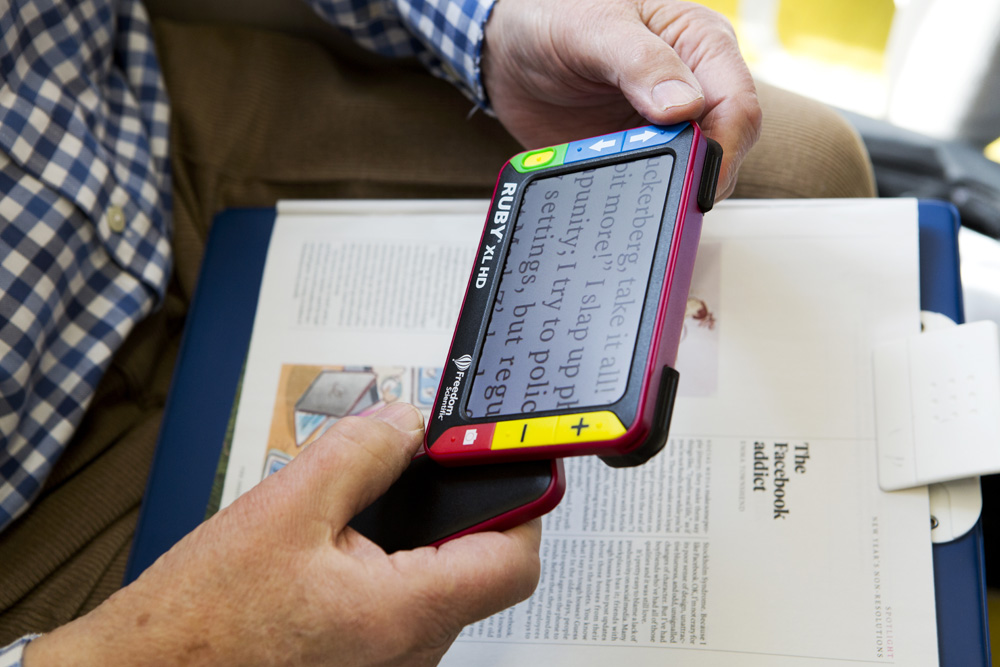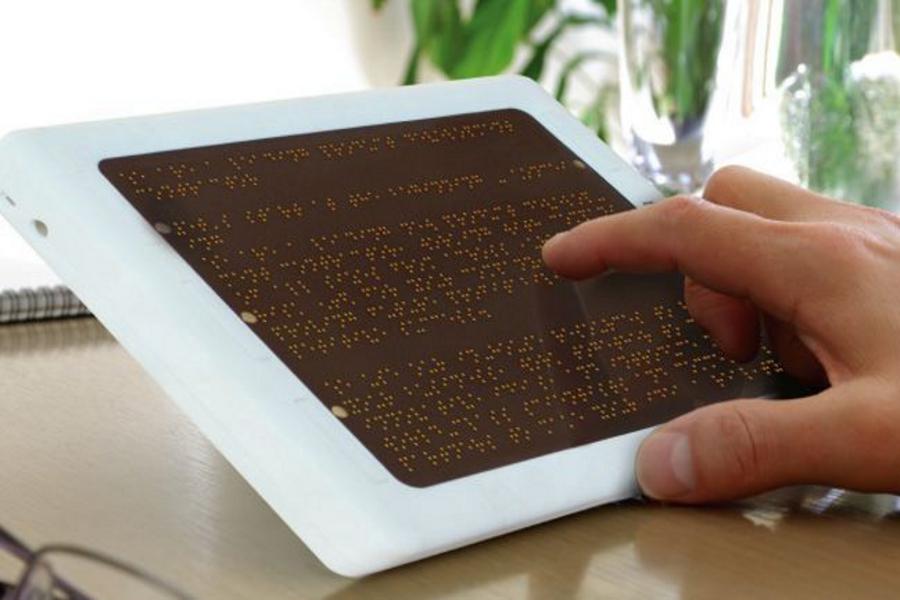Mobility Aids for Visually Impaired Users: Improving Independence
Wiki Article
Discover Innovative Devices Designed for the Visually Impaired
The advancement of cutting-edge tools for the aesthetically damaged stands for a considerable advancement in availability and freedom. Technologies such as clever glasses with AI capabilities and mobile applications designed to offer acoustic descriptions are reshaping daily experiences for users. Furthermore, wearable devices that use haptic comments improve environmental understanding, while modern-day Braille innovations provide brand-new methods to engage with message. As these devices remain to evolve, their effect on the lives of those with aesthetic problems increases vital inquiries concerning the future of inclusivity and freedom in different aspects of life. What lies in advance in this technical landscape?Smart Glasses for Navigating

Smart glasses designed for navigating are changing the way visually damaged people engage with their atmosphere. These innovative devices utilize a combination of electronic camera modern technology, man-made intelligence, and auditory responses to supply real-time details concerning surroundings. By utilizing challenge detection systems, wise glasses can signal customers to possible hazards, enabling much safer wheelchair in both unknown and acquainted settings.
The combination of GPS innovation additionally enhances navigation capabilities, permitting customers to obtain acoustic directions as they relocate. This hands-free approach not just cultivates freedom but additionally encourages aesthetically impaired individuals to browse urban landscapes with increased confidence. In addition, lots of wise glasses are outfitted with functions that identify sites and street indicators, providing contextual info that boosts the customer experience.
In addition, the advancement of these gadgets is consistently progressing, with companies functioning to improve the accuracy of things recognition and increase the variety of navigational functions. As wise glasses end up being a lot more available and affordable, they hold the potential to considerably transform day-to-day live for visually damaged individuals. Inevitably, these cutting-edge devices represent a critical action toward inclusivity, offering improved movement and a greater feeling of autonomy for individuals browsing the globe around them.

Mobile Application for Daily Living
How can mobile applications enhance the lives of aesthetically damaged people? Mobile applications are reinventing the means aesthetically damaged users navigate their atmospheres, manage daily jobs, and access information. These applications supply essential assistance via different performances, promoting freedom and boosting lifestyle.Several cutting-edge mobile apps are designed specifically for everyday living. As an example, applications like Be My Eyes connect aesthetically damaged customers with sighted volunteers by means of video clip telephone calls, permitting them to obtain real-time aid with tasks such as reading tags or navigating unfamiliar areas. Seeing AI, established by Microsoft, utilizes artificial intelligence to describe surroundings, reviewed text, and determine things, properly transforming a smart device into an effective tool for daily aid.
Additionally, navigation applications tailored for the aesthetically damaged, such as Aira and BlindSquare, offer audio-based instructions and ecological information, making it possible for users to traverse their surroundings securely and with confidence. Beyond navigating and instant help, mobile applications additionally sustain organization and job monitoring, with attributes that help individuals set pointers, develop order of business, and track visits. In recap, mobile applications act as crucial resources, encouraging visually damaged individuals to lead more independent and satisfying lives.
Wearable Technologies for Help
Empowerment with modern technology is increasingly noticeable in the realm of wearable tools made to aid visually damaged people. These cutting-edge devices incorporate seamlessly right into daily life, improving navigating and giving essential responses to customers. For example, clever glasses geared up with video cameras can acknowledge faces and review message out loud, enabling individuals to communicate more confidently in social and expert settings.Another noteworthy improvement is using haptic responses systems in wearable gadgets. These systems utilize resonances or various other tactile signals to convey information regarding the user's setting, such as barriers or modifications in terrain, enhancing flexibility and safety and security. Wearable innovations also consist of wristbands that link to mobile phones, signaling users to notices through subtle vibrations, thus improving connection without dependence on aesthetic hints.
As these modern technologies remain to advance, they are not only improving freedom for visually damaged people yet likewise cultivating a higher sense of inclusion in culture. By linking the void between difficulties encountered in day-to-day living and the capacity for autonomy, wearable modern technologies work as critical tools in the quest for equal rights and empowerment for those with visual disabilities.
Sound Description Devices
Audio summary tools play a vital function in enhancing availability for visually impaired people, offering them with the ability to engage with aesthetic media. Speech-to-text devices for low vision. These tools offer narrated summaries of crucial visual elements in films, television shows, and live efficiencies, ensuring that customers can completely understand the context and emotions shared via visualsAudio summary read the full info here can be incorporated right into numerous platforms, consisting of streaming services, movie theater testings, and live theater. Numerous popular streaming services currently consist of audio description as an ease of access function, allowing viewers to pick it quickly. Along with conventional media, specialized apps additionally exist, offering audio summaries for art exhibitions, museums, and various other cultural occasions.
The performance of audio description depends upon the ability of the narrators, that have to communicate aesthetic information succinctly without interfering with the original sound. Developments in this area are also paving the method for even more customized experiences, where customers can adjust the level of information and pacing according to their choices.
Braille Innovations and Gadgets
Braille gadgets and technologies have considerably changed the way visually impaired people connect with message and info. Modern developments have actually led to the advancement of flexible devices that enhance family vision care proficiency and self-reliance among customers.
In addition, portable Braille notetakers integrate standard Braille input with modern-day capabilities, helping with note-taking, organizing, and document modifying on the move. Speech-to-text devices for low vision. These portable tools typically include text-to-speech capabilities, connecting the space in between Braille and auditory information
Furthermore, innovative Braille printers have actually arised, permitting customers to create Braille tags, records, and educational materials efficiently. This availability cultivates higher engagement in educational and specialist environments, eventually advertising inclusivity.
Furthermore, research study into wise Braille modern technologies remains to expand. Gadgets that incorporate expert system are being checked out to supply real-time navigating help and contextual info, enhancing the customer experience in diverse settings. In general, these innovations mirror a dedication to equipping visually damaged individuals with innovation, guaranteeing they can easily gain spectacle frames access to and involve with the globe around them.

Verdict
The innovation of innovative tools for the aesthetically damaged significantly enhances independence and top quality of life. These modern technologies not just foster better incorporation however also advertise freedom in day-to-day tasks, eventually contributing to an extra equitable and easily accessible society for visually damaged people.As smart glasses come to be much more inexpensive and easily accessible, they hold the possible to significantly transform everyday life for aesthetically impaired customers. Mobile apps are reinventing the way aesthetically damaged individuals navigate their atmospheres, handle daily tasks, and gain access to details. Applications like Be My Eyes link aesthetically impaired users with sighted volunteers using video telephone calls, allowing them to receive real-time help with jobs such as checking out labels or navigating unknown rooms.Furthermore, navigating applications customized for the aesthetically impaired, such as Aira and BlindSquare, offer audio-based directions and ecological info, allowing customers to traverse their surroundings safely and confidently.The improvement of innovative tools for the visually impaired dramatically enhances freedom and high quality of life.
Report this wiki page